How to make ventilation in the cellar. Helpful Tips
How to build the most productive ventilation in your cellar or basement and save the harvest until next year? In general, there is nothing complicated here. You just need to accurately calculate everything and acquire the necessary materials and tools.
Dry cellar: do the right ventilation
To start the cellar:
- Clean well and dry.
- All racks must be dismantled, taken upstairs.
- Wash well and dry in the sun.
Disinfect, composition:
- incomplete bucket of cold water;
- about three kilograms of lime;
- 50 g of vitriol.
Remove pests that could get along with fruits and vegetables. For 9 m3 of the cellar is taken:
- Three kilograms of quicklime.
- Place in a container and fill with cold water.
- Immediately you need to leave the cellar and hermetically close it.
- Re-treatment should be done in a week.
For a cellar with a total area (up to 10 m2) for air exchange, you need to take:
- two pipes: section 14 X 14 cm;
- but you can apply one: the cross section is not less than 16 cm.
Make it two-channel. Through the first channel, the air will remain, and through the second it leaves. The cellar must be equipped with a thermometer (alcohol) or a psychrometer.
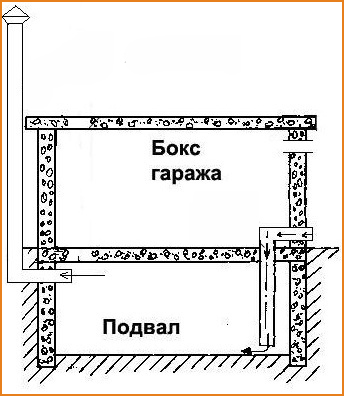
Properly executed ventilation in the garage should:
- Guarantee a continuous flow of fresh air.
- Remove all fumes, heavy odors and moisture.
- Prevent the creation of condensate, and, therefore, damage to provisions and the car.
Now there are several types of supply and exhaust ventilation systems:
- Natural - air exchange in the garage is carried out only due to thermal convection (warmer air rises and exits, and cold air enters from the street). This type of ventilation is more popular and generally available. But it is completely unsuitable: huge areas, in summer, frosty winter days.
- Forced - this is the setting of the fan. Such a ventilation system is the most productive, but will require: obligatory electricity, indispensable material costs.
Rules for installing natural ventilation include:
- one pipe to ensure direct air flow;
- another for output.
The main thing is to arrange the pipes in different angles. And you can do it in several ways:
- Run the pipe through the floor, the roof of the garage.
- Lead out (through any wall of the cellar), then - in a vertical position up, along the entire wall of the garage.
You just need to fulfill a few conditions:
- The correct outlet of the pipe should be: above the level of the garage (more than a meter).
- The total length of the exhaust pipe must be: at least three meters.
- Installing a deflector (to increase traction) in the upper lobe.
Arrangement of the inlet:
- supply closer to the bottom (35–55 cm);
- from floor to ceiling (1.7–2.0).
Forced ventilation: the dissimilarity of this system is the presence of a fan in the exhaust system.
The main thing:
- Choose a model that can be used in high humidity conditions.
- Carry out waterproofing of the electrical equipment used in accordance with all the rules.
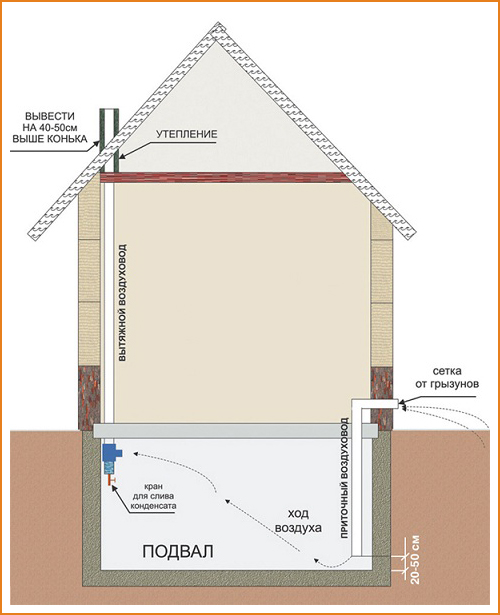
The cellar ventilation system guarantees:
- Good conditions for saving stocks.
- Finding people in the house will remain comfortable.
If the ventilation is set incorrectly:
- It will negatively affect the health of the inhabitants of the house.
- There will be stench and dampness.
- This will have to breathe.
What can be done:
- Forced technique: involves a stationary device - a fan. This is great for huge areas. It is installed on the exhaust pipe.
Can also be used for normal ventilation. For example, only periodically: to dry the cellar. The cellar, which is located under the house, is endowed with some features: the pipe is carried out only through the ground section of the foundation, along the entire wall.
Then, through the entire basement of the house (of course, if it exists). And the prerequisite:
- the pipe must be with the least number of kinks and bends;
- as short as possible;
- preferably without any expansions and narrowings.
In winter, it is desirable to prevent snow from filling the supply pipe. The area that remains outside must be insulated. This will prevent excessive condensate from forming in the pipe.
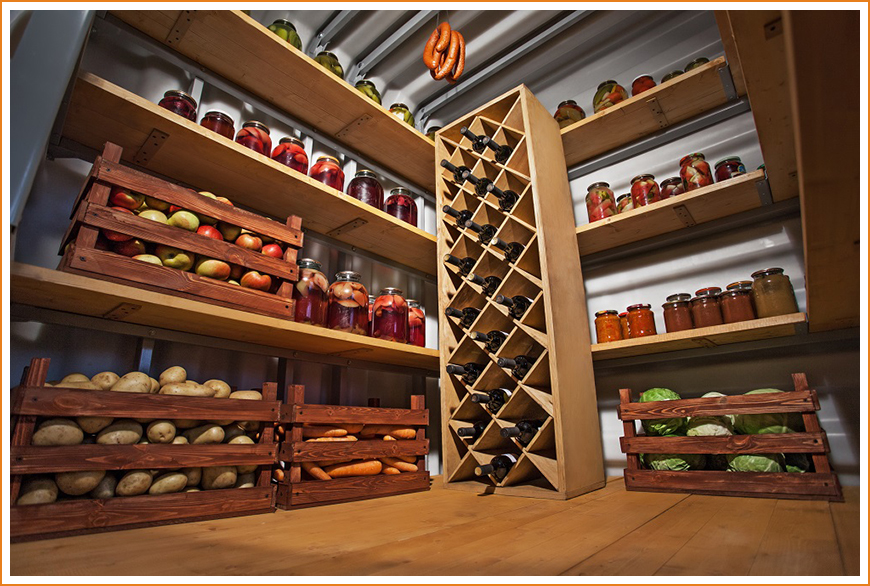
Requests are clear and doable:
- Complete darkness: there are no windows in the cellar, and electric lighting is only available when people are there.
- Low temperature: the cellar is located in the basement.
- Fresh air: supplied by the formation of supply and exhaust ventilation.
- Comparative air humidity: must be no more than 80%.
Only under these conditions will the products be preserved.
Why is cellar ventilation important?
Important for:
- Long-term storage of supplies. And without ventilation, the air becomes damp and musty. This will lead to rapid rotting of the fruit.
- When the ventilation system is excessive, the following problem will arise: drafts will begin to form, which will quickly lead to the drying of vegetables and fruits.
 Ventilation can be difficult, and only specialists can do it. But there is also a fairly simple one and you can do it yourself.
Ventilation can be difficult, and only specialists can do it. But there is also a fairly simple one and you can do it yourself.
The easiest option:
- Knock out holes in the basement: through which clean air will begin to arrive in the basement.
- It is necessary to break through them, on opposite walls.
- It is better to immediately make the holes larger, and be sure to close them with mouse nets. But such ventilation is not very effective.
The best option is to make ventilation using pipes. For this we need:
- the right tools;
- 2 pipes with a diameter of 10–13 cm;
- device for condensate outflow;
- mesh for the supply pipe;
- visor for hood;
- any heater.
Works on the arrangement of supply and exhaust ventilation: a supply pipe will serve to supply the basement with clean air. One side of the pipe should stick out at a distance (50-55 cm) above the level of the entire floor.
And the second one is led up through the basement of the foundation. And they are placed with a distance (about fifty centimeters) above the ground, and covered with a grate. The exhaust pipe hole is located under the very ceiling, and you need to bring it out through all the structures to the roof.
Insulate the section of pipe that will remain on the street. The pipe should be placed (more than half a meter) higher than the roof of the house. It is necessary to cover the hole with a visor so that precipitation in the form of snow, rain does not clog into it.
You need to understand that condensate will accumulate in the pipe and begin to drain to the bottom, it is advisable to put a vessel to collect moisture under it. Pipes are used: galvanized, PVC. When fastening to the walls use: clamps specially designed for this.
Air enters through the supply pipe and exits through the exhaust pipe. The pipes are on opposite sides of the basement, and therefore the movement of air is guaranteed. It is advisable to install such a system on an area of up to 40 square meters. m.
If more, it will not be effective. Then construct forced ventilation. Everything is the same as with natural. Fans are inserted only in the middle of the supply pipe.
From the inside - exhaust (extracting air), and outside driving air inside. Fans need to be turned on at once two at the same time. To choose the most suitable fan, you must consider the dimensions of the basement.
And to choose the required power, the sales assistant will always help. Usually the fan is inserted into the hole channel, then fixed.
It will not be difficult to install it, because manufacturers simplify the work by producing fans that:
- mounted in tin casings and have corrugated edges.
- equipped with fixing brackets.
If you are aware of the diameter of your pipe, then choose the right fan size. You can choose: with a timer, it can be configured.
Some are equipped with a humidity sensor, and are connected only when the humidity exceeds the set parameter. All this will save energy.
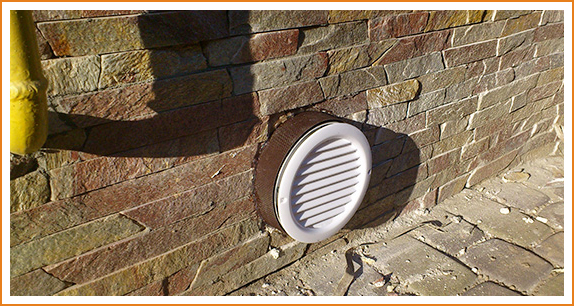
If the room is small, then it is better to use a more lightweight device.
Its main difference:
- Air is delivered and expelled only with the help of a single device (one pipe). Air inflow and exhaust (and a small volume) will be provided by a single pipe.
When the basement is located above ground level, then a great option: air intake with the help of specially designed air ducts with gratings (from rodents). A vent is a small vent or window in a basement wall or foundation.
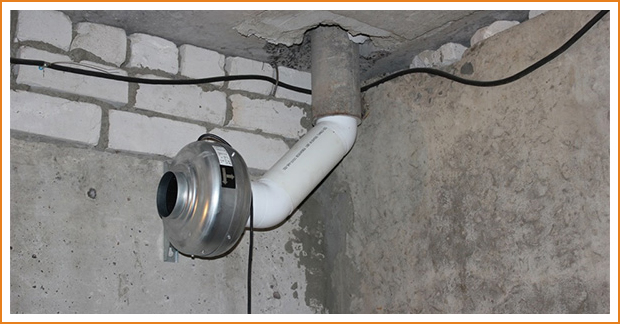
This scheme is used, if necessary, to dry the basement very quickly. If you install a fan in the supply air duct, then the air exchange will be accelerated to the required indicators.
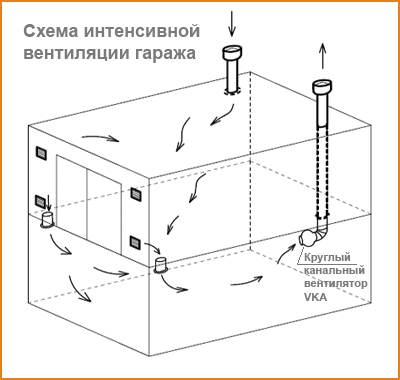
If the basement is very damp, then increased air injection (with the dampers open) will make it possible to dry it very quickly.
If the basement area is large, then it is necessary to install fans in two air ducts at once - this is more rational.
Automated system

If you want to have constant indicators: temperature, humidity. So, you need to use high-quality climatic devices. And for this, you need to turn to specialists. They will find good equipment and install split systems.

It is needed if you begin to use the basement not for storing supplies, but for rest. If the device on certain days will have an obstruction to air exchange. Then there is a need to reorganize the exhaust outlet with the assistance of a fan.
The main thing is not to confuse - you can not put the fan on the supply outlet. Because, with strong air injection, especially if there is no good exhaust, air will be blown out through all kinds of cracks.
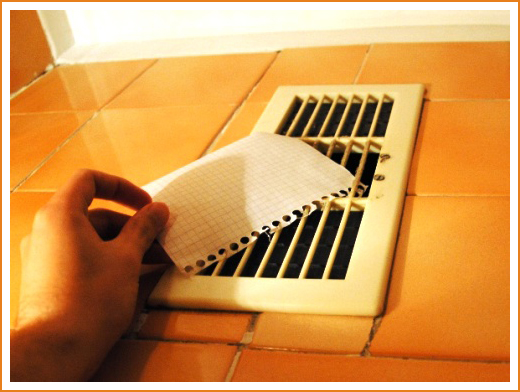
To test the effectiveness of the ventilation system, perhaps as follows:
- They take thin paper and put it on the (ventilation system). If she moves a little, then everything is fine.
- A small container is lowered into the cellar, with hot coals, and they observe. If the ventilation is poor, then it will appear:
- humidity;
- heavy smell;
- condensation on the walls;
- mildew cannot be ruled out.
Improving Efficiency
- To improve aeration (air exchange), you need to: adjust the valves.
- To increase draft: it is better to increase the exhaust pipe (add).
If this does not help, then you need to: perform combined ventilation. To do this, a suitable fan is placed in the exhaust duct. Its power should be no more than 100 watts.
It will blow out stale air, due to which a vacuum will form. And a fresh stream will freely enter the cellar.
A well-mounted ventilation system will contribute to: normalization of air exchange. And it will be able to turn your cellar into a room suitable for storing winter supplies, or another functional area: a workshop, gym, sauna, boiler room, etc.
 Masonry mortars for brick kilns
Masonry mortars for brick kilns Why do the windows fog up in the apartment
Why do the windows fog up in the apartment Construction and schemes of brick ovens
Construction and schemes of brick ovens How to lay paving slabs: tips and tricks
How to lay paving slabs: tips and tricks How to drill bathroom tiles
How to drill bathroom tiles Monolithic slab on coarse soil
Monolithic slab on coarse soil Which electric heater is economical
Which electric heater is economical